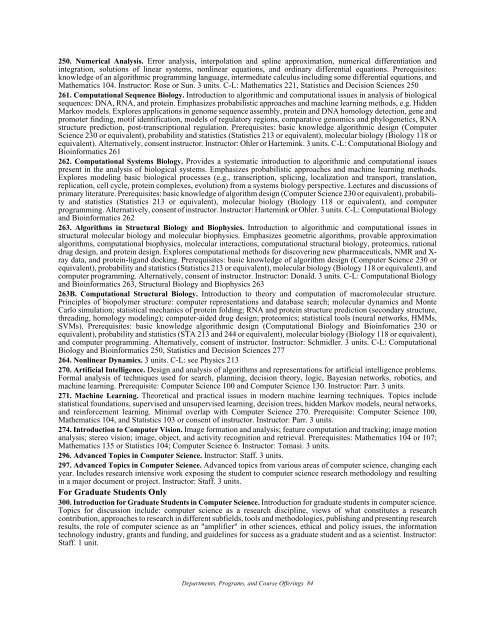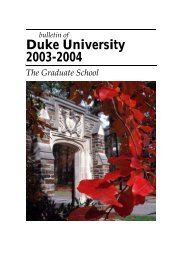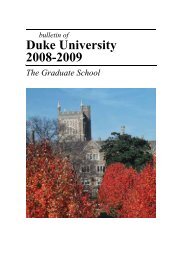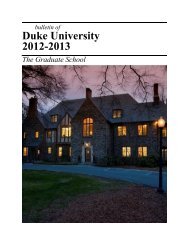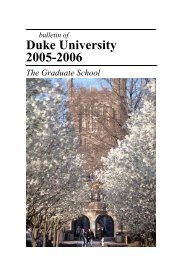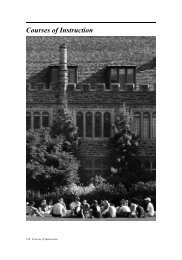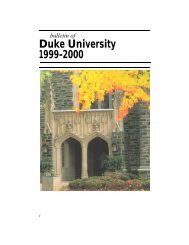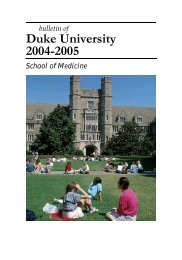Duke University 2009-2010 - Office of the Registrar - Duke University
Duke University 2009-2010 - Office of the Registrar - Duke University
Duke University 2009-2010 - Office of the Registrar - Duke University
You also want an ePaper? Increase the reach of your titles
YUMPU automatically turns print PDFs into web optimized ePapers that Google loves.
250. Numerical Analysis. Error analysis, interpolation and spline approximation, numerical differentiation and<br />
integration, solutions <strong>of</strong> linear systems, nonlinear equations, and ordinary differential equations. Prerequisites:<br />
knowledge <strong>of</strong> an algorithmic programming language, intermediate calculus including some differential equations, and<br />
Ma<strong>the</strong>matics 104. Instructor: Rose or Sun. 3 units. C-L: Ma<strong>the</strong>matics 221, Statistics and Decision Sciences 250<br />
261. Computational Sequence Biology. Introduction to algorithmic and computational issues in analysis <strong>of</strong> biological<br />
sequences: DNA, RNA, and protein. Emphasizes probabilistic approaches and machine learning methods, e.g. Hidden<br />
Markov models. Explores applications in genome sequence assembly, protein and DNA homology detection, gene and<br />
promoter finding, motif identification, models <strong>of</strong> regulatory regions, comparative genomics and phylogenetics, RNA<br />
structure prediction, post-transcriptional regulation. Prerequisites: basic knowledge algorithmic design (Computer<br />
Science 230 or equivalent), probability and statistics (Statistics 213 or equivalent), molecular biology (Biology 118 or<br />
equivalent). Alternatively, consent instructor. Instructor: Ohler or Hartemink. 3 units. C-L: Computational Biology and<br />
Bioinformatics 261<br />
262. Computational Systems Biology. Provides a systematic introduction to algorithmic and computational issues<br />
present in <strong>the</strong> analysis <strong>of</strong> biological systems. Emphasizes probabilistic approaches and machine learning methods.<br />
Explores modeling basic biological processes (e.g., transcription, splicing, localization and transport, translation,<br />
replication, cell cycle, protein complexes, evolution) from a systems biology perspective. Lectures and discussions <strong>of</strong><br />
primary literature. Prerequisites: basic knowledge <strong>of</strong> algorithm design (Computer Science 230 or equivalent), probability<br />
and statistics (Statistics 213 or equivalent), molecular biology (Biology 118 or equivalent), and computer<br />
programming. Alternatively, consent <strong>of</strong> instructor. Instructor: Hartemink or Ohler. 3 units. C-L: Computational Biology<br />
and Bioinformatics 262<br />
263. Algorithms in Structural Biology and Biophysics. Introduction to algorithmic and computational issues in<br />
structural molecular biology and molecular biophysics. Emphasizes geometric algorithms, provable approximation<br />
algorithms, computational biophysics, molecular interactions, computational structural biology, proteomics, rational<br />
drug design, and protein design. Explores computational methods for discovering new pharmaceuticals, NMR and Xray<br />
data, and protein-ligand docking. Prerequisites: basic knowledge <strong>of</strong> algorithm design (Computer Science 230 or<br />
equivalent), probability and statistics (Statistics 213 or equivalent), molecular biology (Biology 118 or equivalent), and<br />
computer programming. Alternatively, consent <strong>of</strong> instructor. Instructor: Donald. 3 units. C-L: Computational Biology<br />
and Bioinformatics 263, Structural Biology and Biophysics 263<br />
263B. Computational Structural Biology. Introduction to <strong>the</strong>ory and computation <strong>of</strong> macromolecular structure.<br />
Principles <strong>of</strong> biopolymer structure: computer representations and database search; molecular dynamics and Monte<br />
Carlo simulation; statistical mechanics <strong>of</strong> protein folding; RNA and protein structure prediction (secondary structure,<br />
threading, homology modeling); computer-aided drug design; proteomics; statistical tools (neural networks, HMMs,<br />
SVMs). Prerequisites: basic knowledge algorithmic design (Computational Biology and Bioinfomatics 230 or<br />
equivalent), probability and statistics (STA 213 and 244 or equivalent), molecular biology (Biology 118 or equivalent),<br />
and computer programming. Alternatively, consent <strong>of</strong> instructor. Instructor: Schmidler. 3 units. C-L: Computational<br />
Biology and Bioinformatics 250, Statistics and Decision Sciences 277<br />
264. Nonlinear Dynamics. 3 units. C-L: see Physics 213<br />
270. Artificial Intelligence. Design and analysis <strong>of</strong> algorithms and representations for artificial intelligence problems.<br />
Formal analysis <strong>of</strong> techniques used for search, planning, decision <strong>the</strong>ory, logic, Bayesian networks, robotics, and<br />
machine learning. Prerequisite: Computer Science 100 and Computer Science 130. Instructor: Parr. 3 units.<br />
271. Machine Learning. Theoretical and practical issues in modern machine learning techniques. Topics include<br />
statistical foundations, supervised and unsupervised learning, decision trees, hidden Markov models, neural networks,<br />
and reinforcement learning. Minimal overlap with Computer Science 270. Prerequisite: Computer Science 100,<br />
Ma<strong>the</strong>matics 104, and Statistics 103 or consent <strong>of</strong> instructor. Instructor: Parr. 3 units.<br />
274. Introduction to Computer Vision. Image formation and analysis; feature computation and tracking; image motion<br />
analysis; stereo vision; image, object, and activity recognition and retrieval. Prerequisites: Ma<strong>the</strong>matics 104 or 107;<br />
Ma<strong>the</strong>matics 135 or Statistics 104; Computer Science 6. Instructor: Tomasi. 3 units.<br />
296. Advanced Topics in Computer Science. Instructor: Staff. 3 units.<br />
297. Advanced Topics in Computer Science. Advanced topics from various areas <strong>of</strong> computer science, changing each<br />
year. Includes research intensive work exposing <strong>the</strong> student to computer science research methodology and resulting<br />
in a major document or project. Instructor: Staff. 3 units.<br />
For Graduate Students Only<br />
300. Introduction for Graduate Students in Computer Science. Introduction for graduate students in computer science.<br />
Topics for discussion include: computer science as a research discipline, views <strong>of</strong> what constitutes a research<br />
contribution, approaches to research in different subfields, tools and methodologies, publishing and presenting research<br />
results, <strong>the</strong> role <strong>of</strong> computer science as an "amplifier" in o<strong>the</strong>r sciences, ethical and policy issues, <strong>the</strong> information<br />
technology industry, grants and funding, and guidelines for success as a graduate student and as a scientist. Instructor:<br />
Staff. 1 unit.<br />
Departments, Programs, and Course Offerings 84


